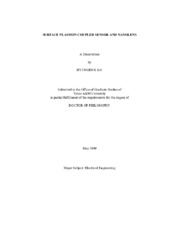| dc.description.abstract | This dissertation consists of two topics. One is a "Multi-pass Fiber Optic Surface
Plasmon Resonance Sensor (SPR)" and the other is a "Nano-metallic Surface Plasmon
Lens." Since both topics involved surface plasmon, the title of this dissertation is named
"Surface plasmon coupled sensor and nanolens."
For a multi-pass fiber optic SPR sensor, a fiber optic 4-pass SPR sensor coupled
with a field-assist capability for detecting an extremely low concentration of charged
particles is first demonstrated. The multipass feature increases the sensitivity by a factor
equal to the number of passes. The field-assist feature forces charged particles/molecules
to the SPR surface, increasing the sensitivity by an additional factor of about 100.
Overall, the sensitivity exceeds the one-pass SPR device by a factor of about 400. A 10
pM concentration of 47 nm diameter polystyrene (PS) latex beads and 1 ?M
concentration of salt dissolved in DI water were detected within a few seconds by the
combined system. The equivalent index resolution for atomic size corresponding to
ionized chlorine in salt is 10-8. This technique offers the potential for sensitive and fast
detection of biomolecules in a solution. Secondly, a 44-pass fiber optic surface plasmon
resonance (SPR) sensor coupled with a field-assist capability for measurement of refractive index change due to positive and negative ions is shown. The field-assist
feature forces ions to the SPR surface, causing the SPR signal response to change which
reflects a decrease or increase in refractive index depending on whether positive or
negative ions are being attracted to the surface. This technique offers the potential for the
sensitive detection of cations and anions in a solution.
For a nano-metallic surface plasmon lens, we analyze the transmission of a
normally incident plane wave through an Ag/dielectric layered concentric ring structure
using finite difference time domain (FDTD) analysis. The dependency of the
transmission efficiency on the refractive index in slit is studied. The numerical analysis
indicates that the focusing beyond diffraction limit is found even at the extended focal
length comparable to the distance of 7" from the exit plane using a circularly polarized
coherent plane wave, ?=405 nm. Especially, compared to an Ag-only structure, the Ag/
LiNbO3 structure amplifies the transmission power by a factor of 6. Therefore, this
Ag/dielectric layered lens has the potential for significantly higher resolution imaging
and optical data storage. | en |


